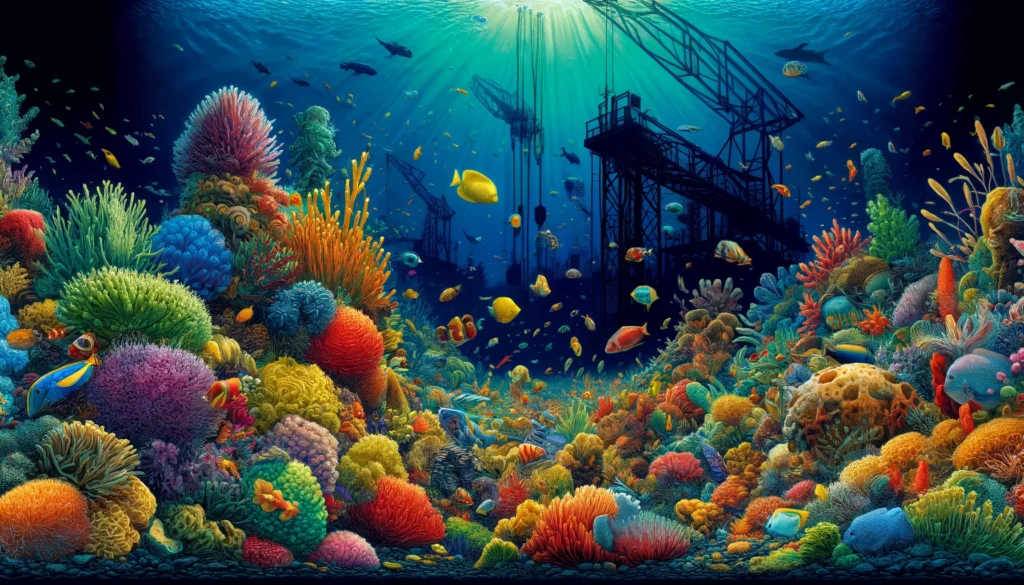Beneath the vast, dark expanse of the world’s oceans lies a realm so remote and unexplored that it rivals the mystery of outer space. This enigmatic world, known as the deep sea, harbors secrets and resources that have captivated the human imagination and scientific curiosity for decades. Among these is the alluring prospect of deep-sea mining, a venture that promises to unearth a treasure trove of valuable minerals critical for our modern technology and renewable energy sectors. Yet, this promise is not without its perils, as the venture stirs a contentious debate over its potential to become an ecological disaster.
Deep sea mining, the process of retrieving mineral deposits from the ocean floor, is viewed by some as a golden opportunity to meet the burgeoning demand for essential minerals like cobalt, nickel, and rare earth elements. These minerals are the building blocks of today’s high-tech industry, driving the production of everything from smartphones to electric vehicle batteries, and are touted as being pivotal for the green energy transition. However, the prospect of mining the ocean’s depths is met with apprehension by environmentalists and marine scientists who warn of the untold damage that could be inflicted on some of the planet’s most pristine and least understood ecosystems.

The debate over deep sea mining encapsulates a broader dilemma faced by humanity: how to balance the relentless pursuit of economic development with the imperative to preserve our natural environment. As the world stands on the precipice of this new frontier, it is imperative to delve into the complexities of deep-sea mining, exploring its potential rewards and risks. This blog post aims to unravel the intricate tapestry of economic allure and environmental concerns that deep sea mining presents, navigating through the murky waters of this global issue to uncover whether it is indeed a treasure trove or an ecological disaster waiting to unfold.
The Allure of the Deep Sea: Unveiling the Treasure Trove
- What is Deep Sea Mining?
Deep sea mining is an innovative process that involves extracting mineral resources from the seabed, particularly in areas beyond national jurisdiction known as the abyssal plains. This underwater operation targets rich deposits like polymetallic nodules, cobalt-rich crusts, and seafloor massive sulfides, which contain precious metals such as copper, nickel, and rare earth elements. Utilizing advanced technologies like remotely operated vehicles (ROVs) and autonomous underwater vehicles (AUVs), deep-sea mining seeks to tap into these hidden reserves, offering a new frontier in mineral exploitation.

- Economic Potential and Technological Advances
The economic allure of deep sea mining is significant, driven by the increasing global demand for metals essential in high-tech industries, renewable energy solutions, and electric vehicles. As terrestrial resources become scarcer and harder to extract, the deep sea presents a vast, albeit challenging, resource base. The technological strides in underwater exploration and extraction have turned the once-unfeasible idea of deep-sea mining into a potential industrial reality. Innovations in robotics, telemetry, and material science have enabled safer and more effective ways to explore and exploit deep-sea mineral deposits. These advancements not only promise to broaden our resource base but also to revolutionize the way we mine, reducing the environmental footprint compared to traditional land mining methods.
- Global Interest and Investment
The prospect of deep-sea mining has sparked global interest and investment, drawing in a mix of state actors, private companies, and international consortia. Countries like China, Japan, and Canada, alongside companies with technological and financial capabilities, are at the forefront of this venture, keen on securing access to these underwater treasures. The regulatory framework, governed by the International Seabed Authority (ISA), sets the legal and environmental standards for exploration and exploitation activities in international waters. As stakeholders navigate these regulations, the race to harness the deep sea’s mineral wealth underscores the strategic importance of these resources in the global economy.
The Environmental Quandary: Ecological Concerns of Deep Sea Mining
- Threats to Marine Biodiversity
The deep sea, a realm of profound mystery and diversity, hosts ecosystems that are both delicate and little understood. Mining activities in these depths pose significant threats to marine biodiversity. The extraction process, which involves disturbing the seafloor, can destroy habitats and displace myriad species, from the microscopic to the more complex organisms that thrive in these unique environments. The potential for long-term damage is high, as deep-sea ecosystems often have slow recovery rates due to their low natural energy environments. Concerns also revolve around sediment plumes generated by mining operations, which can spread far from the extraction sites, smothering marine life and disrupting ecological functions across vast areas of the ocean floor.

- Scientific Uncertainties and Environmental Risks
The full extent of the environmental impact of deep-sea mining remains shrouded in uncertainty, primarily due to our nascent understanding of deep-sea ecosystems. Scientific research indicates that the removal or disturbance of seabed minerals could have unforeseen consequences, potentially triggering chain reactions within the marine ecological web. Issues such as noise, light pollution, and chemical releases from mining processes could alter the sensory and biological dynamics of deep-sea life. Moreover, the risk of accidental spills and equipment failures poses a significant threat to these fragile environments. The paucity of baseline data on deep-sea biodiversity and the lack of comprehensive environmental impact assessments amplify the risks, making it challenging to predict long-term outcomes and implement effective mitigation strategies.
- Regulatory and Conservation Challenges
Navigating the regulatory and conservation challenges of deep sea mining is a complex task, especially given the international nature of the ocean’s seabed. The International Seabed Authority (ISA) plays a crucial role in establishing guidelines and regulations to mitigate environmental impacts, yet enforcing these in the vast, unmonitored expanses of the deep sea is fraught with difficulties. The lack of stringent, enforceable international standards and the pressure from various stakeholders keen on exploiting deep-sea resources complicate conservation efforts. As such, the need for robust, transparent, and adaptive regulatory frameworks is critical to ensuring that deep-sea mining activities do not irreparably harm marine ecosystems.
Balancing Act: Navigating Between Wealth and Conservation
- Sustainable Mining Practices and Innovations
As the world grapples with the dual demands of resource extraction and environmental preservation, the concept of sustainable mining practices in the deep sea becomes paramount. Innovations in mining technology and methodologies are continually being developed to minimize the ecological footprint of these operations. For instance, precision extraction techniques aim to reduce the disturbance to the seabed and surrounding ecosystems, while closed-system mining operations seek to prevent the release of sediment and pollutants into the water column. Additionally, real-time monitoring systems can help in managing and mitigating the environmental impacts of mining activities. These advancements, coupled with a commitment to continuous scientific research, are vital in developing a framework for responsible deep-sea mining that balances economic interests with ecological sustainability.

- Global Dialogue and Future Prospects
The future of deep sea mining is not just a matter of technological feasibility but also of international cooperation and dialogue. The debate around deep sea mining transcends national boundaries, necessitating a global conversation that includes governments, industries, scientists, and civil society. This dialogue must strive to establish a consensus on sustainable practices, equitable resource distribution, and environmental protection. As the international community continues to negotiate the terms under which deep-sea mining should proceed, the focus should be on creating comprehensive, transparent, and enforceable regulations that ensure the long-term health of marine ecosystems. Looking ahead, the ability to harness the treasures of the deep sea without compromising its ecological integrity will be a testament to human ingenuity and our collective commitment to sustainable development.
Conclusion
The journey through the depths of deep sea mining reveals a narrative rife with contrasts: the allure of untapped mineral wealth versus the imperative to protect our planet’s last untouched ecosystems. As we’ve navigated the promising yet precarious landscape of extracting resources from the ocean floor, it’s clear that deep sea mining embodies a critical test of our collective ability to balance economic aspirations with ecological responsibility.
The discourse around deep sea mining is not merely about the extraction of minerals but also about the broader questions of sustainability, environmental ethics, and global governance. The potential to tap into the ocean’s mineral riches offers a tantalizing prospect for advancing human technology and economy, yet it comes with the weighty responsibility to safeguard the marine habitats that are vital to our planet’s biodiversity and ecological health.

In conclusion, deep sea mining presents a formidable challenge, one that demands careful consideration, rigorous scientific research, and robust international collaboration. As we stand on the brink of venturing into these abyssal depths, it is imperative that decisions are guided by a vision that prioritizes long-term environmental stewardship alongside economic gain. The path we choose to follow will not only shape the future of deep sea mining but also reflect our broader commitment to preserving the Earth’s natural heritage for generations to come.
By fostering an informed and engaged global community, we can ensure that the treasure trove of the deep sea does not become an ecological disaster, but rather a sustainable asset that contributes to the prosperity and well-being of our planet and its inhabitants.
Author’s Note
This blog post aims to illuminate the intricate balance between the technological advancements and economic opportunities presented by deep-sea mining and the urgent need to address its environmental implications. As we delve into the abyssal realms of our oceans, it is crucial to foster a dialogue that prioritizes sustainable and responsible exploration and exploitation of deep-sea resources.
G.C., Ecosociosphere contributor.
References and Further Reading
- “The Deep: The Extraordinary Creatures of the Abyss” by Claire Nouvian – This book provides insight into the fascinating biodiversity of deep-sea ecosystems, offering a visual and scientific exploration of life in the ocean depths.
- “Deep Sea Mining: Science, Technology, and Mineral Resources” by Rahul Sharma – This comprehensive text delves into the technical aspects of deep-sea mining, discussing the potential resources and the technological challenges involved.





Comments
Can you be more specific about the content of your article? After reading it, I still have some doubts. Hope you can help me.
Thanks for sharing. I read many of your blog posts, cool, your blog is very good.
I don’t think the title of your article matches the content lol. Just kidding, mainly because I had some doubts after reading the article.
Thank you for your sharing. I am worried that I lack creative ideas. It is your article that makes me full of hope. Thank you. But, I have a question, can you help me?
Thanks for sharing. I read many of your blog posts, cool, your blog is very good.
Thank you for your sharing. I am worried that I lack creative ideas. It is your article that makes me full of hope. Thank you. But, I have a question, can you help me?
Your article helped me a lot, is there any more related content? Thanks!
I am really inspired together with your writing abilities and also with the layout to your weblog. Is this a paid subject matter or did you customize it yourself? Either way stay up the excellent quality writing, it’s rare to peer a great weblog like this one these days!
Your article helped me a lot, is there any more related content? Thanks!